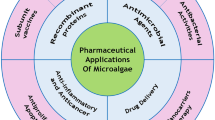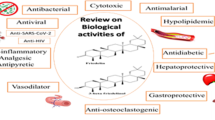Abstract
Colominic acid is an α2,8-linked sialic acid polymer produced by Escherichia coli. We found that synthetic sulfated-colominic acids (SC) remarkably inhibited the cytotoxicity of bee and snake venom toward mouse fibroblast cells, but colominic acids showed no inhibition themselves, indicating the important role of sulfate groups in the inhibitory activity of SC. Other sulfated carbohydrates such as chondroitin sulfates, heparin and heparan sulfate showed no inhibition. SC also exhibited potent inhibition of melittin, a highly basic peptide, which is a major cytotoxic component of bee venom. SC did not inhibit phospholipase A2 activity in bee venom. This suggests that the inhibition of bee and snake venom by SC is due to inhibition of melittin and cardiotoxin, which is a cytolytic peptide in snake venom, respectively. SC with a higher sulfur content and a larger molecular mass showed more potent activity. The interaction between SC and melittin basically seems an ionic one, however, the conformation of SC is also likely important. For the binding of SC to melittin leading loss of its cytotoxic activity, the sulfate groups of SC must be properly arranged to interact with lysine and arginine residues of melittin molecules, which play an important role in the cytolytic activity. A higher molecular mass of SC substituted with more sulfate groups is required for more obvious inhibition of the cytotoxic activity.
Similar content being viewed by others
References
Hemmerich S, Rosen SD (1994) Biochemistry 33: 4830–35.
Tsuboi S, Isogai Y, Hada N, King JK, Hindsgaul O, Fukuda M (1996) J Biol Chem 271: 27213–16.
Fiete D, Srivastava V, Hindsgaul O, Baenzinger JU (1991) Cell 67: 1103–110.
Fiete D, Beranek MC, Baenzinger JU (1998) Proc Natl Acad Sci USA 95: 2089–93.
Roche P (1991) Cell 67: 1131–43.
Loquin J, Lorted G, Ferro M, Mear N, Prome J-C, Boivin C (1997) J Bacteriol 179: 3079–83.
Nishimura SI, Kai H, Shimada K, Yoshida T, Tokura S, Kurita K, Nakashima H, Yamamoto N, Uryu T (1998) Carbohydr Res 306: 427–33.
Itoh M, Baba M, Hirabayashi K, Matsumoto M, Suzuki M, Shigeta S, Clerq DE (1989) Eur J Clin Microbiol Infect Des 8: 171–73.
Barry GT, Abbot V, Tsai T (1962) J Gen Microbiol 29: 335–52.
Silver RP, Finn CW, Vann WF, Aaronson W, Schneerson R, Kretschmer PJ, Garm CF (1981) Nature 289: 696–98.
Hatanaka K, Koizumi M, Kunou M, Ohtsuki T (1997) Glycocojugate J 14: S-91.
Svennerholm L (1957) Biochem Biophys Acta 24: 604–11.
Terho TT, Hartiala K (1971) Anal Biochem 41: 471–76.
Ishiyama M (1993) Chem Pharm Bull 41: 1118–22.
Habermann E (1972) Science 177: 314–23.
Sessa G, Freer JH, Colacicco G, Weissmann G (1969) J Biol Chem 244: 3575–82.
Hincha DK, Crowe JH (1996) Biochem Biophys Acta 1284: 162–70.
Habermann E (1980) In Natural Toxins (Eaker D, Wadstrom T, eds) pp 173–81. Oxford: Pergamon Press.
Schroeder E, Luebbe K, Lehman M, Beetz I (1971) Experimentia 27: 764–65.
Dufton MJ, Hider RC (1991) In SnakeToxins (Harvey AL, ed) pp 259–302. New York: Pergamon Press Inc.
Batenburg AM, Bougis PE, Rochat H, Verkleiji AJ, de Kruijiff B (1985) Biochemistry 24: 7101–110.
Patel HV, Vyas AA, Vyas KA, Liu Y-S, Chinag C-H, Chi L-M, Wu W-G (1997) J Biol Chem 272: 1484–92.
Louw AI (1974) Biochem Biophys Res Commun 58: 1022–29.
Condrea E, Barzilay M, Mager J (1970) Biochim Biophys Acta 210: 65–73.
Bougis PE, Marchot P, Rochat H (1987) Toxicon 25: 427–31
Kakehi K, Kinoshita M, Oda Y (1999) Anal Chem 71: 1592–96.
Author information
Authors and Affiliations
Rights and permissions
About this article
Cite this article
Oda, Y., Kinoshita, M., Hamada, K. et al. Sulfated sialic acid-polymers inhibit the cytotoxic action of bee and snake venom. Glycoconj J 16, 457–463 (1999). https://doi.org/10.1023/A:1007074410201
Issue Date:
DOI: https://doi.org/10.1023/A:1007074410201




